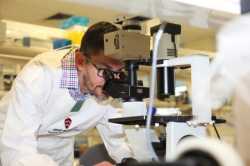Author Interviews, Biomarkers, Breast Cancer / 11.08.2015
New cancer marker may be key to tailored chemotherapy treatment in hard to treat breast cancer – Cancer vaccine target?
 MedicalResearch.com Interview with: Dr Stephen Chan DM, FRCR, FRCP
Consultant Oncologist Breast and Gynaecological Cancers
Nottingham University Hospitals Trust
Honorary Professor at the University of Nottingham
Visiting Professor of Cancer Medicine at Nottingham Trent University
MedicalResearch: What is the background for this study? What are the main findings?
Dr. Chan: Worldwide each year 1.68 million women are diagnosed with breast cancer and more than half a million die from the disease. Of these new cases around 12% will be classified as triple negative breast cancer (TNBC), meaning that tumour cells from these patients do not show any of the three established clinical markers that can be treated with targeted therapies. These drugs are used in addition to standard chemotherapy to improve the chance of a good treatment response, leading to prolonged disease free survival. Without these additional treatment options triple negative patients are forced to depend entirely on chemotherapy to treat their cancer.
Traditionally the sensitivity of a cancer to different types of chemotherapy has been categorised is based on a tumours tissue of origin and stage. There is currently no predictive marker of response that would allow chemotherapy treatment to be tailored to individual patients. With this information a clinician can predict which patients would benefit most from a particular chemotherapy and switch any who would do poorly to an alternative. The result would be a shift to increased treatment efficacy, while avoiding toxicity from ineffective treatment, which would in turn also reduce the cost to the health service. This need is particularly acute in triple negative breast cancer cases where chemotherapy is the cornerstone of treatment.
In collaboration with researchers based at Nottingham Trent University our group has been successful in finding new markers, which can predict how a patient will respond to chemotherapy treatment. One of these is HAGE (DDX43), a DEAD box RNA helicase. We have found that high HAGE expression predicts good respond to one of the main first line chemotherapy drugs, called anthracycline (Tarek MA Abdel-Fatah et al, April 2014). Our recent work (Tarek MA Abdel-Fatah, 2015) has shown that the predictive value is strong in triple negative breast cancer cases.
(more…)
MedicalResearch.com Interview with: Dr Stephen Chan DM, FRCR, FRCP
Consultant Oncologist Breast and Gynaecological Cancers
Nottingham University Hospitals Trust
Honorary Professor at the University of Nottingham
Visiting Professor of Cancer Medicine at Nottingham Trent University
MedicalResearch: What is the background for this study? What are the main findings?
Dr. Chan: Worldwide each year 1.68 million women are diagnosed with breast cancer and more than half a million die from the disease. Of these new cases around 12% will be classified as triple negative breast cancer (TNBC), meaning that tumour cells from these patients do not show any of the three established clinical markers that can be treated with targeted therapies. These drugs are used in addition to standard chemotherapy to improve the chance of a good treatment response, leading to prolonged disease free survival. Without these additional treatment options triple negative patients are forced to depend entirely on chemotherapy to treat their cancer.
Traditionally the sensitivity of a cancer to different types of chemotherapy has been categorised is based on a tumours tissue of origin and stage. There is currently no predictive marker of response that would allow chemotherapy treatment to be tailored to individual patients. With this information a clinician can predict which patients would benefit most from a particular chemotherapy and switch any who would do poorly to an alternative. The result would be a shift to increased treatment efficacy, while avoiding toxicity from ineffective treatment, which would in turn also reduce the cost to the health service. This need is particularly acute in triple negative breast cancer cases where chemotherapy is the cornerstone of treatment.
In collaboration with researchers based at Nottingham Trent University our group has been successful in finding new markers, which can predict how a patient will respond to chemotherapy treatment. One of these is HAGE (DDX43), a DEAD box RNA helicase. We have found that high HAGE expression predicts good respond to one of the main first line chemotherapy drugs, called anthracycline (Tarek MA Abdel-Fatah et al, April 2014). Our recent work (Tarek MA Abdel-Fatah, 2015) has shown that the predictive value is strong in triple negative breast cancer cases.
(more…)




















